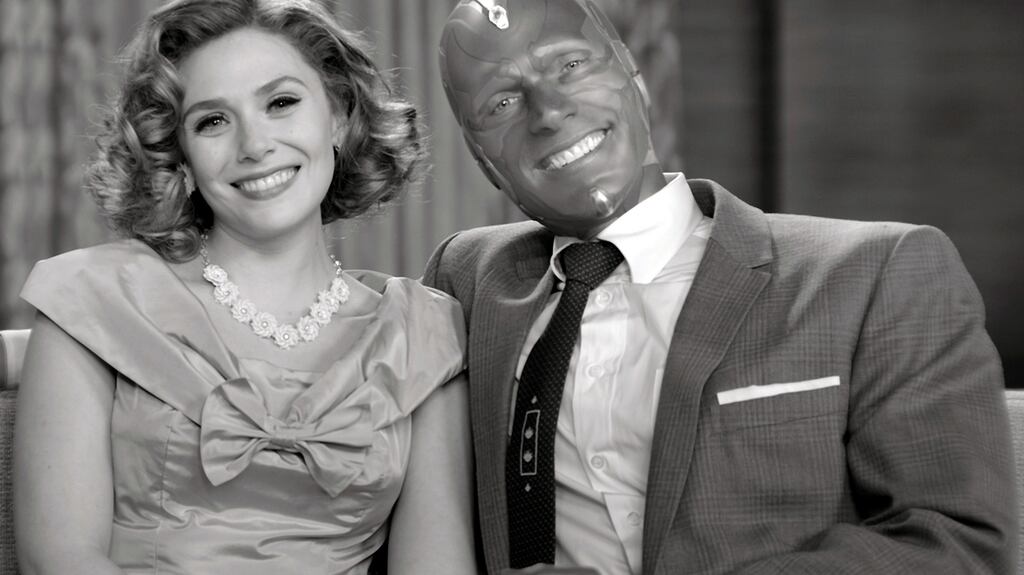Think twice before writing obituaries for any venerable genre or format. The record album is not what it once was, but great excitement still greets the "dropping" of a new Lana Del Rey or Beyoncé LP. The notion of TV episodes arriving seven days apart is not dead either.
The Netflix binge was supposed to have annihilated the creaky analogue concept of the weekly TV episode. Henceforth, series would land in one fat lump we could plough through at our own leisure (or our own orgiastic bender). Sure, solid-fuel viewers may still, while puffing meerschaum pipes at legacy channels such as BBC2 or RTÉ1, wait seven days to see if Adrian Dunbar would again say "I didn't float down the Lagan in a bubble" on Line of Duty. No streamer would, however, indulge such 20th century rituals. Why, we may as well shoot shows in black and white on the old Academy ratio. Ha, ha!
Do you see what I did there? Disney+’s WandaVision, like the same channel’s The Mandalorian, has confirmed there is still life in a convention dreamt up when televisions still had dials. Other streamers have delivered the odd drip-feed series, but Disney+ seems admirably committed to the Eisenhower model.
Mark Graham, editor-in-chief of Decider, was among those dissenting. "Maybe WandaVision will play better when the whole season is available to watch, but dribbling out this series in weekly 30-minute chunks is not something that holds any appeal for me three episodes in," he wrote. Really?
In case you've missed the chatter, WandaVision, featuring Elizabeth Olsen and Paul Bettany as Marvel heroes Scarlet Witch and Vision, plays out as a series of parodies on American domestic sitcoms from successive eras. We begin — in, yes, monochrome Academy — with an I Love Lucy vibe and move on through the tropes of Bewitched, The Brady Bunch, Family Ties and Malcolm in the Middle. Like those shows, WandaVision dribbles out in "weekly 30-minute chunks". The pause between broadcasts gives viewers a chance to ponder the apparently inexplicable propulsion of the characters into TV meta-landscapes, but it is also part of the aesthetics being parodied. If ever a series were designed to arrive in the old fashion it is WandaVision.
The success of that show and of The Mandalorian — the most consistently praised entry to the Star Wars universe since the franchise re-emerged in 2015 — confirms that good things really do come to those who wait. The series gets time to sink into the zeitgeist. Fans can discuss each episode on social media with less fear that spoilers from down the line will inhibit their enjoyment (a baffling obsession in contemporary pop cultural discourse).
What Dallas fan would, if the option were available in 1980, have failed to click straight to the next episode after JR Ewing's famous shooting?
It is only eight years since this conversation began. In early 2013, the New York Times ran a headline announcing: “New Way to Deliver a Drama: All 13 Episodes in One Sitting”. The series in question was Netflix’s House of Cards. Always alive to the shifting sands, the streamer had observed the rise of binge-watching — originally making use of DVD “box sets” — and concluded that, if viewers want to watch the whole thing in one unstoppable gulp, then that is what they should be allowed to do. “In some corners of Hollywood there is deep scepticism about Netflix’s all-at-once release,” the Times reported. The sceptics were proven wrong.
This alteration in delivery systems was part of a wider belief that certain broadcast TV conventions were no longer worth observing. Why did every episode have to be the same length? After all, you no longer had to tidy up the murder mystery in time for The Riordans at eight o’clock. Some episodes of David Fincher’s excellent Mindhunter were as short as 42 minutes; others stretched out to 71 minutes. There was no reason an episode couldn’t be shorter than a Bugs Bunny cartoon. If punters felt short-changed, they could immediately click straight on to the succeeding show. Heck, it might be feature length.
As the New York Times noted, it nonetheless required a degree of chutzpah to deliver all House of Cards episodes in one package. That was not how TV worked. Disney’s current strategy also involves some bravery.
Netflix felt it was giving people what they wanted. What Dallas fan would, if the option were available in 1980, have failed to click straight to the next episode after JR Ewing’s famous shooting? Never mind cliff-hangers. If you had enjoyed a new episode of Seinfeld in 1990 then you might reasonably have jumped at the chance to immediately watch another.
The partial shift back to staggered release — shows such as Apple TV’s Ted Lasso have also revisited the traditional pattern — confirms that, like responsible parents policing the Quality Street box, streaming services are prepared to deny their customers what they thought they desired. “We understand you want all of The Mandalorian now,” they are not quite saying. “But you will better enjoy it if you don’t gorge yourself in a five-and-a-half-hour binge.”
Very sensible advice. Now go to your room.












